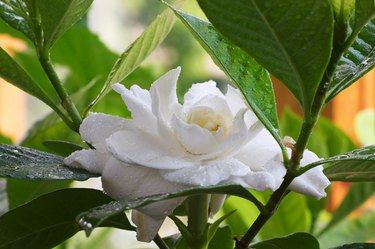
Gardenias (Gardenia augusta or Gardenia jasminoides) bloom with unmistakable large, white flowers that have a beautiful fragrance. Although the shrub is definitely a feast for the senses, it takes a lot of work to maintain its appeal. One problem that plagues home gardeners is yellowing leaves on gardenia plants, and these can be caused by a multitude of issues.
Temperatures and Age
Video of the Day
It's common -- and normal -- for gardenia leaves to turn yellow when temperatures turn. In particular, this happens when warm days are followed by cool nights during fall and spring in many climates. In addition, gardenia leaves may suffer if they are continually exposed to cold temperatures. Hardy in U.S. Department of Agriculture plant hardiness zones 8 through 11, the plants prefer warmth over cold, and temperatures below 70 degrees Fahrenheit can cause the leaves to turn yellow. Because of this, home gardeners often grow gardenias in containers and bring them indoors for the winter; some cultivate them as houseplants only. Finally, as the plant ages, the most mature leaves often turn yellow -- usually the ones on the lower branches of the plant. This happens mostly in the springtime as new growth appears.
Video of the Day
Lack of Nutrients
Plants become chlorotic when they don't get enough nutrients, and the primary symptom of this is yellowing leaves. Gardenias are particularly susceptible to this because they're acid-loving plants. If the soil has a pH level of 7.0 or above -- gardenias prefer 5.0 to 6.0 -- the plant will not be able to absorb iron and other nutrients. To combat this, feed your gardenia with a fertilizer formulated for acid-loving plants. The specific instructions will vary depending on the brand, but in general, dilute 1 tablespoon in 1 gallon of water. Use distilled water if your tap water is hard, because hard water can also cause the leaves to yellow. Feed the gardenia in March and again in June, using this solution to water the soil thoroughly,. Do not feed the gardenia in late summer or early fall. Indoor plants should be fertilized once a month from March through August.
Pest Infestations
Insect pests can be a serious problem for gardenias, especially those grown indoors as houseplants. Sap-sucking insects in particular, such as aphids, white flies and spider mites, can cause the leaves to turn yellow. Aphids are green, white or tan, and usually cluster on the undersides of leaves. White flies are tiny white bugs that swarm when you disturb the plant; spider mites leave distinctive white webbing on the plant's leaves and stems. Scales and thrips can also plague gardenias. On small plants and houseplants, a strong stream of water is often enough to wash away the bugs. Larger plants and those suffering from serious infestations will likely need an application of insecticidal oil or herbicide to eradicate the pests. Instructions will vary depending on the particular pest and the product you use. In general, ready-to-use sprays should be applied until the leaves are dripping, including the undersides of the leaves, once a week for three weeks. Apply in late afternoon or early evening when the weather is dry and still, and when temperatures are below 90 degrees Fahrenheit.
Deadly Diseases
Diseases that destroy the roots of the plant are a common cause of yellowing gardenia leaves. These "root rot" diseases are usually caused by fungi that live in the soil and attack the plant's roots, rotting them away and leaving the gardenia unable to absorb nutrients and water. The plant begins to weaken and die, and one of the first symptoms is usually yellowing leaves. To prevent root rot diseases, make sure your gardenia is planted in well-draining soil. Only plant gardenias in containers with adequate drainage holes in the bottom. Gardenias like continually moist soil, so water just enough to keep it barely moist but not waterlogged or muddy. If the plant's roots are destroyed, it's best to throw it out and avoid planting more gardenias in the same location. Powdery mildew, a fungal disease that attacks the foliage, can also cause yellowing of the leaves. This can be avoided by giving the plant plenty of room to allow air to circulate and by watering at ground level to avoid wetting the leaves.
- Missouri Botanical Garden: Gardenia Jasminoides
- University of Florida IFAS Extension: FAQs -- Landscape Plants
- Clemson Cooperative Extension: Gardenia Diseases & Other Problems
- Jacksonville.com: Garden Q&A -- Why Are Gardenia's Leaves Turning Yellow?
- Clemson Cooperative Extension: Gardenia Insects & Related Pests